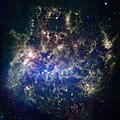File:Magellanic Cloud.jpg

Size of this preview: 600 × 600 pixels. Other resolutions: 240 × 240 pixels | 480 × 480 pixels | 768 × 768 pixels | 1,024 × 1,024 pixels | 2,048 × 2,048 pixels | 13,250 × 13,250 pixels.
Original file (13,250 × 13,250 pixels, file size: 58.1 MB, MIME type: image/jpeg)
File history
Click on a date/time to view the file as it appeared at that time.
| Date/Time | Thumbnail | Dimensions | User | Comment | |
|---|---|---|---|---|---|
| current | 10:49, 28 December 2011 |  | 13,250 × 13,250 (58.1 MB) | Prof. Professorson | Highest resolution, from http://www.spitzer.caltech.edu/images/1670-ssc2006-17b1-Large-Magellanic-Cloud-in-the-Infrared (http://www.spitzer.caltech.edu/uploaded_files/images/0006/2139/ssc2006-17b1.jpg). |
| 10:20, 28 December 2011 |  | 6,000 × 6,000 (7.32 MB) | Bulwersator | full image (from source) | |
| 10:14, 28 December 2011 |  | 516 × 387 (63 KB) | Bulwersator | Transferred from en.wikipedia: see original upload log above |
File usage
The following page uses this file:
Global file usage
The following other wikis use this file:
- Usage on en.wikipedia.org
- Usage on id.wikipedia.org
- Usage on it.wikibooks.org
- Usage on vi.wikipedia.org

